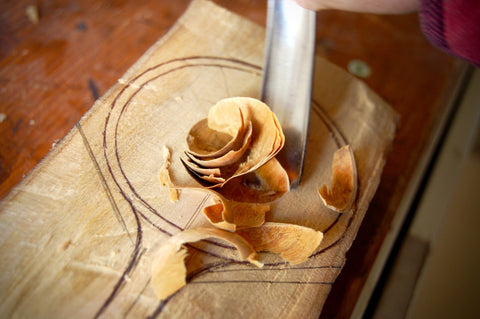
James Carroll - Woodsman
Posted by Anna Crudge in: handmade, irish furniture, James Carroll, sycamore stool

What do you make?
I make various types of furniture and occasionally both larger wooden things and smaller wooden things. For the most part, the furniture is for sitting on, individual and made of local wood.
Could you describe your studio to us? What is your favourite thing about the space
and how do you get into the mindset of making?
I worked outdoors on trestles for about two years before I built my workshop. When it rained I'd put the tools away. I wanted to make the workshop I had imagined. I knew if I cobbled something together temporarily I wouldn't ever get around to building it. So I also spent that time gleaning materials. Thankfully the only thing I ended up actually buying off the shelf was some steel RSJ's for the uprights, some clear roof panels, and the electrics. It was difficult to complete but I’m glad I did it that way.
I love the fact that it is right next to where I live and so accessible. It is often quite disorganised and crammed full of all sorts. Too much usually. I am always working on improving and changing it. When I do a Big Tidy (about once a month) I get a real creative rush to mess it up again.

What is your favourite tool and why? Where do they come from?
I do like Japanese carpentry tools. A few years ago, after a three-day workshop, the Japanese saw sharpener Nagakatsu gave me a Nokogiri saw he had tuned and sharpened. It was new but made from steel he had procured from a batch of blades made in 1950's. A real humdinger. I was not/am not worthy.
Can you describe the making process and inspiration behind your stools?
For me, it usually starts with the materials and the story behind them. Even if
it is not apparent in the finished piece it is the part of the process that interests me most.

What led you to choosing this craft as a profession? What do you love most about it?
I was always interested in making things and seeing how they are made. I didn't
consciously decide to make it a profession but just kept doing it I suppose. Now though I only do it for the money.
You can purchase James' Sycamore Stools both online and from our Drury street location.

Maker Stories
Posted by Clare Grennan in: handmade, handweaving, heritage craft, Irish craft
Visitors to our shop love to hear the story behind the item they are purchasing. In an age of mass production, the handmade is still, thankfully, cherished by many. Over the Summer, we will be highlighting a selection of our favourite stockists who are masters of their chosen craft from wood turning to weaving. Every week, we will add a new story which will give an insight into a specific making process and the life of a craftsperson, from their favourite process and studio set up, to what led them to pursue a career in craft and design.
Our first maker story featuring Nicola Gates of Olla Nua will be posted early next week.

A Range of Cufflinks
Posted by Clare Grennan in: contemporary jewellery, cufflinks, geometric jewellery, handmade

Our very own jewellery line Names Dublin was launched last Autumn. Even after months of brainstorming and experimenting in the studio, we could not have predicted how popular it would prove to be. Over the months leading up to Christmas, we noticed how much our male customers seemed to really love the jewellery, the appeal being the bold geometric shapes, the matte and polished surfaces, the satisfying weight of the brass.
The idea of producing a range of cufflinks seemed like a natural progression for Names, and so in January we began prototyping. What has always bothered myself and Laura about cufflinks are the backs, how flimsy they tend to be, an afterthought to the design of the front. Our focus was to produce each cufflink as one complete shape, giving equal importance to the front and back, ensuring both complimented each other perfectly. Constructed in three parts, each cufflink has been formed by cold connection, as in there was no soldering involved. By using this process, the end result is much cleaner and a strong geometric design is achieved.
The overall process, from initial drawings to finished pieces has been a challenge, but we are really pleased with the end result. The four designs in the range are named after our fathers and grandfathers, John, George, Martin and Mick. Each set of cufflinks is available in either rose or yellow 18carat gold plated brass and packaged in our custom made jewellery boxes.

Helen Faulkner - Process & Planters
Posted by Anna Crudge in: Áras, Down Arts Centre, handmade, Helen Faulkner
We have been fans of Helen Faulkner's work for some time now, the contrast between the dark terracotta clay and the creamy coloured glazes she uses is very appealing. We were delighted when she agreed to create a range of plant pots for Áras, our new collection of home wares. We interrupted the production of our new plant pots with a few questions about what inspires her work and how it is made.

How did you first get into working with clay?
I was introduced to clay during a foundation art course but the first time I got to trying throwing on the potters wheel was a couple of years later on my Contemporary Craft Degree in England and from then on it was all I wanted to do.
What inspires the shapes and colours of your pieces?
My inspiration comes from how the pots are going to be used. I love cooking and eating! So my tableware range is all about food, a smooth curve on the base of a mug that rests comfortably in the hand or thinking about what colours the food will look great on, such as a leafy green salad in a bright blue bowl.
You have designed a collection of plant pots for us, what was the most challenging aspect of the project? what was the most enjoyable?
Making a final decision on decoration was hard, throughout the design process I go through so many ideas that it can be hard to settle on just one. I really enjoyed going through the design ideas sent sent through by yourselves, trying to pull out the most important aspects of the design to you and bringing them together with my style and ideas, it's a challenge I enjoy!

What sort of plants do you envisage people putting in the pots? Did you have something specific in mind when designing/prototyping?
With the tall pot I can imagine spider plants, the stripy leaves that droop down would be a great contrast against the rich red clay. I can imagine mini cactus in the shallow pot but something a bit more useful would be an aloe vera plant. A row of tall plant pots would also look great in the kitchen with herbs in them, again I just can't help but bring it back to food!
Are you currently working on any other new/exciting projects?
I'm working towards a group exhibition that's happening in Down Arts Centre where I have my studio, it's part of August Craft Month in Northern Ireland that is a month long collection of events celebrating crafts, lots of workshops and talks happening too.
What is the greatest and worst part of being self employed?
The best part of being self employed, aside from making pots every week, is the control over my working life and deciding what is important for me. The hardest part of being self employed is nearly the same thing, having to control every aspect is a massive juggling act and sometimes I mess it up but it's all learning so I just start again the next day!
Finally, what do you most like to do on your days off? Do you give yourself days off?
I spend my spare time cooking, I love spending time in the kitchen although I usually end up with a lot of dishes to do because I like to use all the pots I’ve collected over the years! My dog Sheva, who spends her days in the studio with me keeping an eye on things, takes up the rest of my day with walks.
Click here to shop some of Helen's fabulous pots and planters made exclusively for the Irish Design Shop ARAS collection.


Tito The Spoon Maker
Posted by Anna Crudge in: Galway craft, handmade, Irish Design, permaculture

Florida born and Dublin reared Alberto Hogan is better known as Tito, or Tito The Spoon maker to give him his full title. Based in Galway for the last few years he’s spent his time there honing his craft. It was obviously time well spent, we've fallen in love with his beautifully crafted spoons and kitchen utensils and thought it time to share our love. We caught up with him to gain some insights into the life of a kitchen utensil maker.
What first sparked your interest in spoon making?
Around 2009 my wife introduced me to Permaculture design. It was from here that I started my journey into learning and understanding more about ecological design and traditional crafts. We both did a bushcraft course down in Kerry which involved a lot of knife skills, fashioning traps, shelters, tools etc. and it was there that I literally fell in love with the ability to make everything I need to live well in a forest with just a knife or a few simple hand tools using the wilderness around me as raw materials.
After this course, I continued carving. The shape of the spoon really allowed me to practice essential carving skills and also helped me understand the wood I was working with. As I was making my spoons I was posting them online, I saw that they got a lot of interest and one day I had a request to make 5 of them and it was this that sparked the idea of starting a small business.

Can you take us through your process?
First I go to the mills and lumber yards to look for wood, usually beech, cherry and walnut boards. I fill up my little jeep and then head home to plan out the next step.
I use cardboard templates to draw out the spoon shapes on the boards. Once I am satisfied with that I then go to Tuam where I use a friends shed space to cut the spoon shapes out. Ideally, a bandsaw is what would be used for this but since I have to be mobile I use a jigsaw to cut them out. Cutting takes about a day and I end up going home with a crate full of spoon blanks.
At home I can then scoop out the bowls and smooth then out using a sanding disc attached to a drill. Next I rough out the shape using my trusty axe.

Once the general shaping of the spoon is done I can then move on to the knife, carving and slicing the piece down to its final shape. Then I smooth out the rim of the bowl, evening out any rough surfaces and giving it that nice sharp transition from rim to inner bowl and then a more btle transition from rim to outer bowl where the knife marks are.A gentle pass of a polishing sponge really gives that silky smooth finish to the touch.
Using a pyrography pen I burn in the decorative lines. Burning into the cherry wood makes the smoke smell like cherry.
And finally a gentle pass of raw linseed oil makes the wood grain really highlight its beauty and creates a protective layer that slowly penetrates the wood, making it ready to use in the kitchen.

What do you find inspiring about your work?
One main thing that inspires me to do my work is that even if I have to make 10 or 20 of the same spoon, each one is going to be different.
Some can be a delight to make others can be very tricky but this makes the work exciting and refreshing every time. I love the idea that I am making something that is functional and long lasting, using a beautiful natural material that is regenerative and biodegradable and in my opinion, better looking with age.

What are the main challenges you face?
Right now, the major obstacle is not having a dedicated workspace where I can make my spoons and utensils in peace.
Being in an apartment I am quite limited with the axe since it makes quite a loud and continuous pounding sound. Generally during the day everyone is out working leaving me alone to chop away merrily but if it's an urgent job and I need to finish a lot of work then I head back out to my friends shed in Tuam and spend the day completing all of the axe work. For now, making my spoons in these conditions is fine but it does have its limits.

What does the future hold? do you plan to expand into other kitchen ware or stay true to being a spoon-maker?
I applied for this space in the Spiddal Craft Village so if that works out I can then be producing at 100%. Having a dedicated space means I can explore and develop so much more and yes, I definitely want to expand into different areas producing bowls, cups, boards and more unique one-off pieces but I also want to produce tools as well. I have been throwing some ideas around with some local blacksmiths about collaborating in making handmade tools for carpentry and forestry, things like chisels, knives, axes, drawknives, froes and adzes.
Like wooden spoons, these tools never get outdated and in reality many of the hand tools produced back when it was just wood, steel and leather are as quick and effective as any of their power-tool counterparts that are overly complex and require electricity.
Spoons, I think I will always make, and this title of spoon-maker will be a reminder to me of where it all began.
Tito's spoons are a great addition to any kitchen and look great paired with Dunbeacon pottery.


